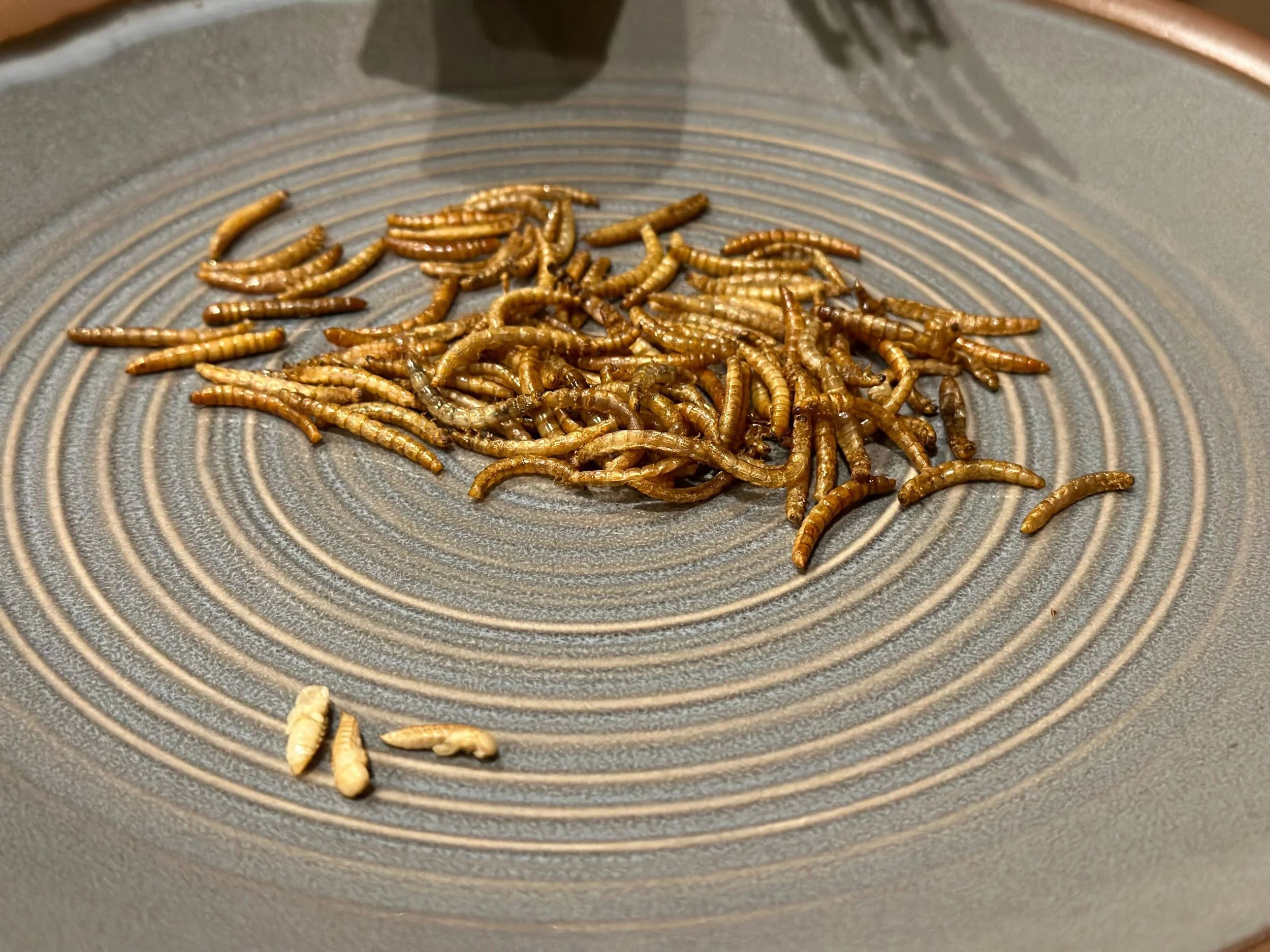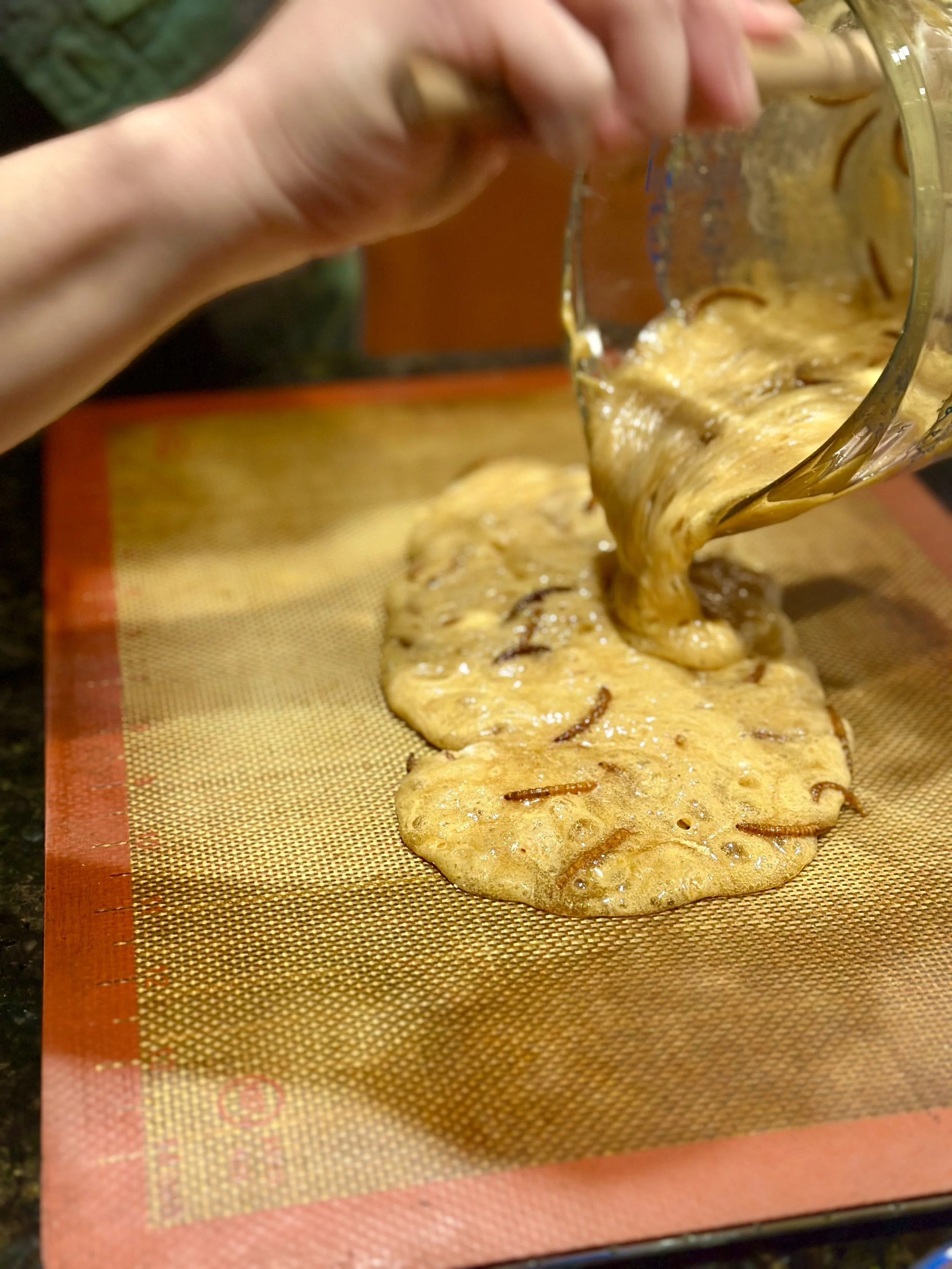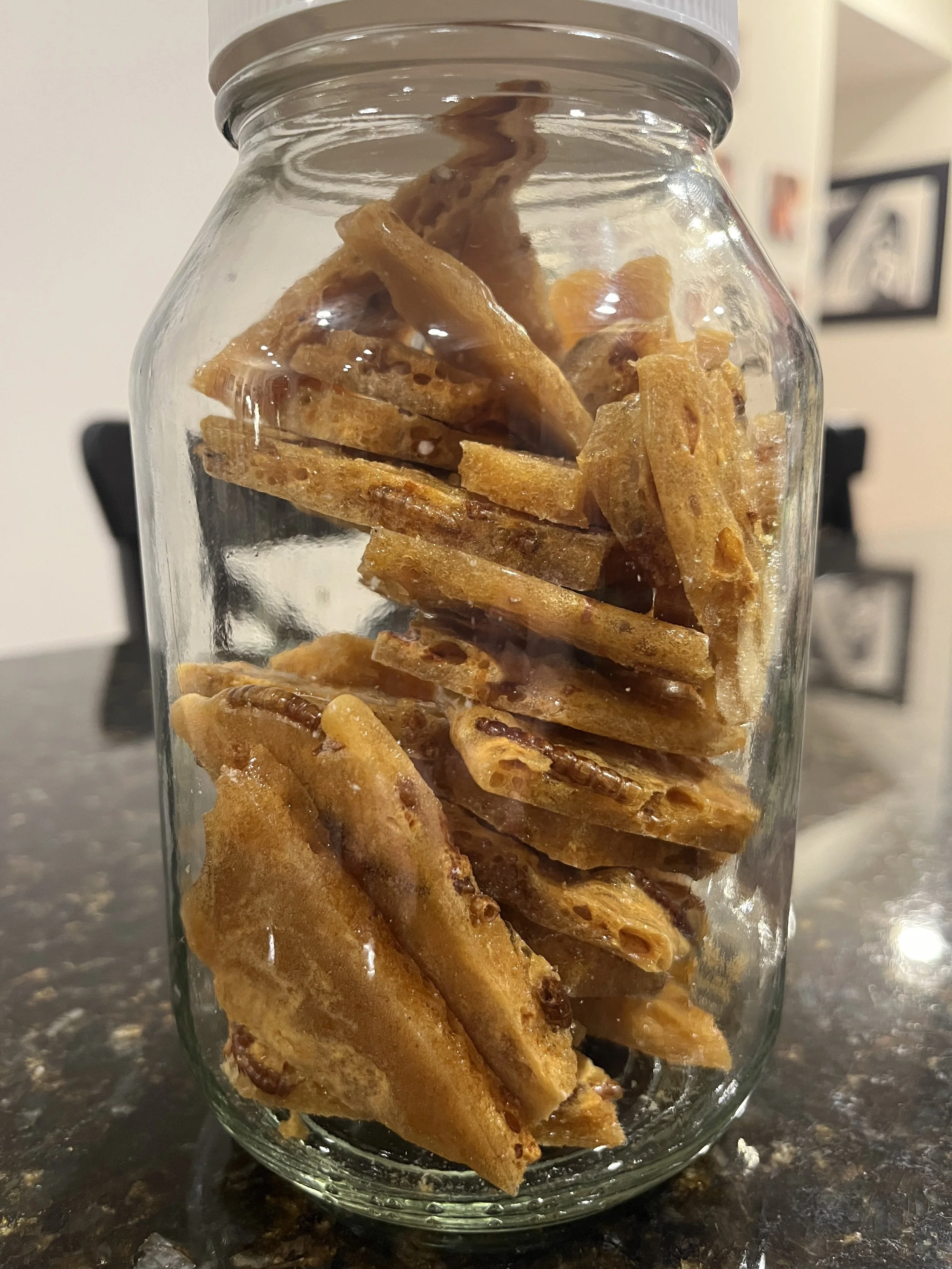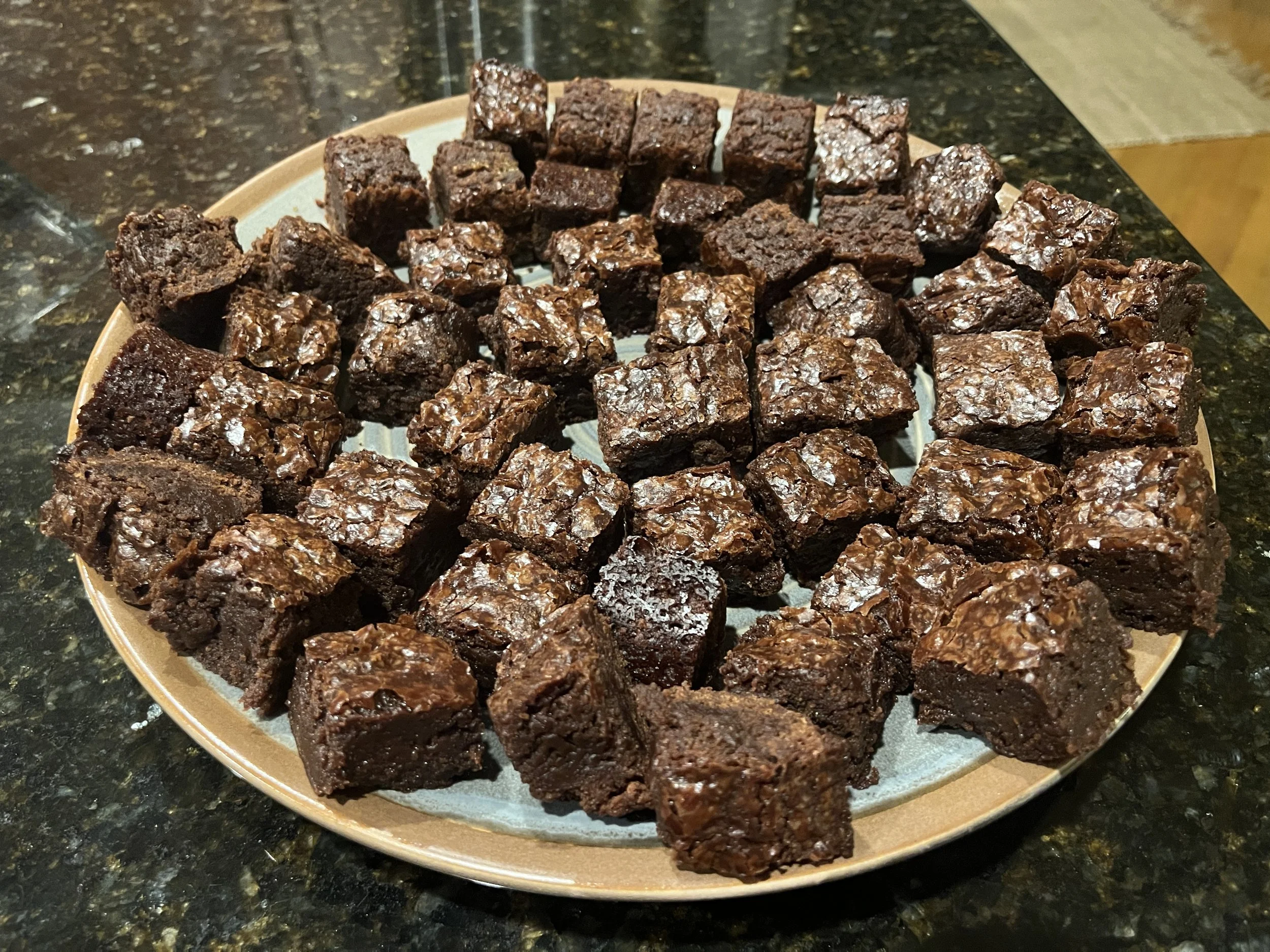PI: Sarah Ku | Undergraduate Researcher: Michael Hughey
Toasting mealworm larvae
Toasted mealworm larvae and pupae
Pouring mealworm brittle
Bug brittle (whole mealworms)
Bug brownies (ground mealworms)
Researchers Michael Hughey and Sarah Ku
Abstract
Current agricultural practices have the capacity to feed the world’s population. However, transporting food to people who need it constrains these efforts. Food production is often centralized outside of dense urban populations, furthering separating people from food. Edible insect cultivation poses a sustainable alternative that addresses each facet of food sovereignty: access to enough, nutritious, and culturally significant food. With over 2,000 species of known edible insects around the world, this small livestock (i.e., mini-livestock) offers myriad benefits, including high protein content, vitamins, minerals, and amino acids, all while requiring relatively few inputs. This research investigates the viability of small-scale insect cultivation for human consumption. In the US, insects are a rare niche or specialty food item, receiving early market and regulatory attention. Given its current nascency, we focus on the US market to examine its business capacity for market opportunities for this sustainable food source. Mini-livestock offer opportunities for maximizing space efficiency, feed requirements, water availability, protein conversion ratios, and consumer access since it can be done in urban settings. We examine the business market for edible insects through ecological frameworks of resilience and adaptive theory. Over 2 million people worldwide already feature insects in their diets, suggesting viability on a macro scale to address global food insecurity and the need for shifts in conventional agricultural systems to respond to climate change. We contribute transdisciplinary theoretical framing to offer insights on how businesses can leverage resources and constraints in modern contexts to address food sovereignty.
BACkground information
The FAO estimates a need for a 70-100% increase in food production to support the increasing population
Stamer, A. (2015). Insect proteins—a new source for animal feed: The use of insect larvae to recycle food waste in high‐quality protein for livestock and aquaculture feeds is held back largely owing to regulatory hurdles. EMBO reports, 16(6), 676-680Up to 98% of insect protein is readily digestible by humans and insects have favorable levels of protein compared to beef and pork
Bessa, L. W., Pieterse, E., Sigge, G., & Hoffman, L. C. (2020). Insects as human food; from farm to fork. Journal of the Science of Food and Agriculture, 100(14), 5017-5022Insects provide opportunities to help address challenges of sustainable consumption
Collins, C. M., Vaskou, P., & Kountouris, Y. (2019). Insect food products in the western world: assessing the potential of a new ‘green’market. Annals of the Entomological Society of America, 112(6), 518-528
The global edible insects market is estimated to be worth $16.39 billion by 2032
https://www.meticulousresearch.com/pressrelease/184/edible-insects-market-2032Edible insects represent a growing industry in USA but still receives relatively little attention in research
Cadinu, L. A., Barra, P., Torre, F., Delogu, F., & Madau, F. A. (2020). Insect rearing: Potential, challenges, and circularity. Sustainability, 12(11), 4567The United States has considerable regulations on insects for animal feed but remains lacking in regulations for human consumption through the Food and Drug Administration
Hunts, H. J., Dunkel, F. V., Thienes, M. J., & Carnegie, N. B. (2020). Gatekeepers in the food industry: acceptability of edible insects. Journal of insects as food and feed, 6(3), 231-243
Methods
Much of the literature surrounding insects involves identifying consumer behavior (e.g., awareness, education, willingness to adopt, how to alter perceptions)
Yanagawa, Y. (2023). How can businesses reframe insects as food?: A case study of a restaurant in Berlin (Master's thesis, University of Twente)Given the finite resources and capacity of this biosphere, we are reaching a point of collapse
Lawrence, K. S., & Abrutyn, S. B. (2015). The degradation of nature and the growth of environmental concern: Toward a theory of the capture and limits of ecological value. Human Ecology Review, 21(1), 87-108Adaptability and transformability are necessary for an equitable, sustainable, and resilient food system
Tendall, D. M., Joerin, J., Kopainsky, B., Edwards, P., Shreck, A., Le, Q. B., ... & Six, J. (2015). Food system resilience: Defining the concept. Global Food Security, 6, 17-23
Findings
Collective and collaborative action is needed to make our food systems more sustainable
Grinnell-Wright, V., Wilson, J., & Downing, P. (2013). Review of evi dence on consumer food-related behaviours that impact on sus tainability: Final Report. A report for Best Foot ForwardInsects offer opportunities for small-scale, decentralized, nutritious food sovereignty to address food insecurity in urban spaces
Barragán-Fonseca, K. Y., Barragán-Fonseca, K. B., Verschoor, G., van Loon, J. J., & Dicke, M. (2020). Insects for peace. Current opinion in insect science, 40, 85-93Food once unfamiliar or shunned have found their way into modern Western cuisine (e.g., lobster, sushi, kale, quinoa, olive oil, tomatoes)
Butner, J., & Shockley, M. (2019). Eating insects Athens conference 2018 and the North American coalition for insect agriculture. Annals of the Entomological Society of America, 112(6), 500-504
Conclusion
We incorporate an interdisciplinary approach by leveraging ecological theories for business frameworks for modern markets. We must update the ways in which we operate our food systems if we hope to have access to enough, nutritious, and culturally-relevant food for everyone. Insects offer opportunities to be proactive in this transition that can help propel us into a more sustainable future with more equitable access to food.














